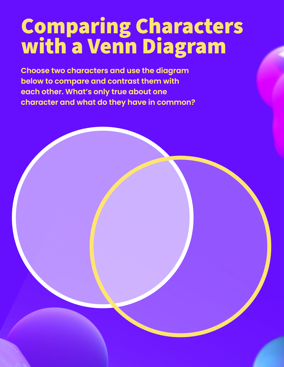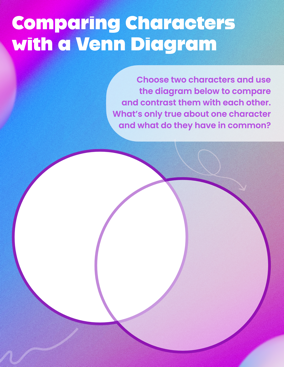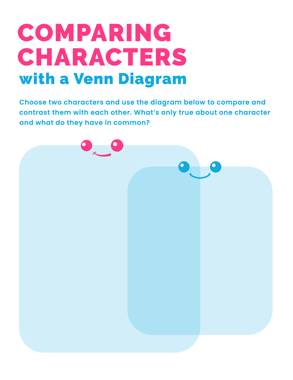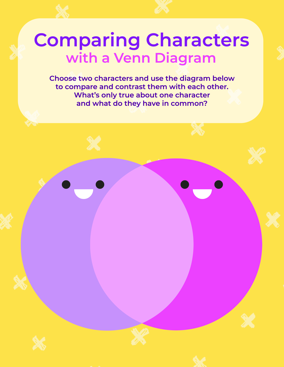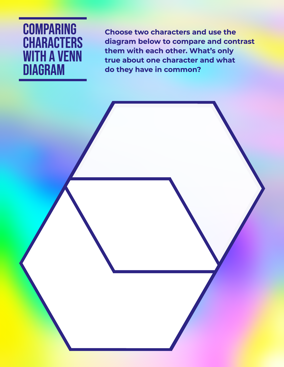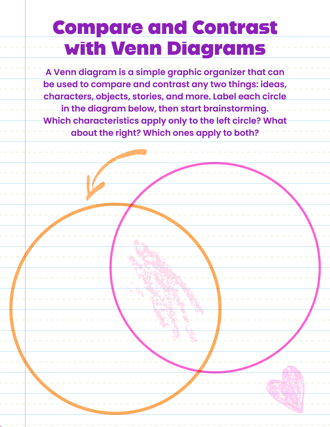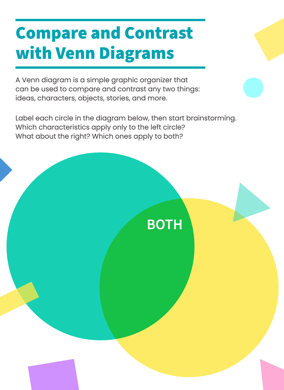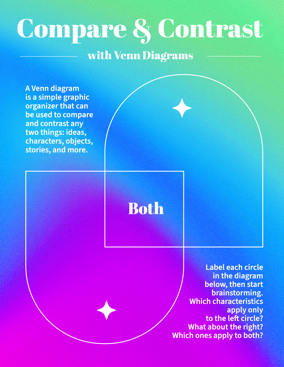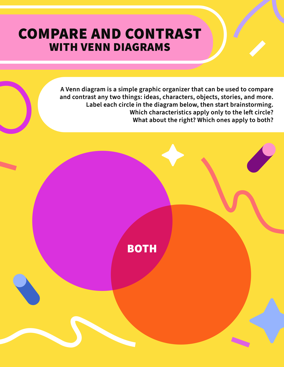Using Venn diagrams to level up teaching strategies
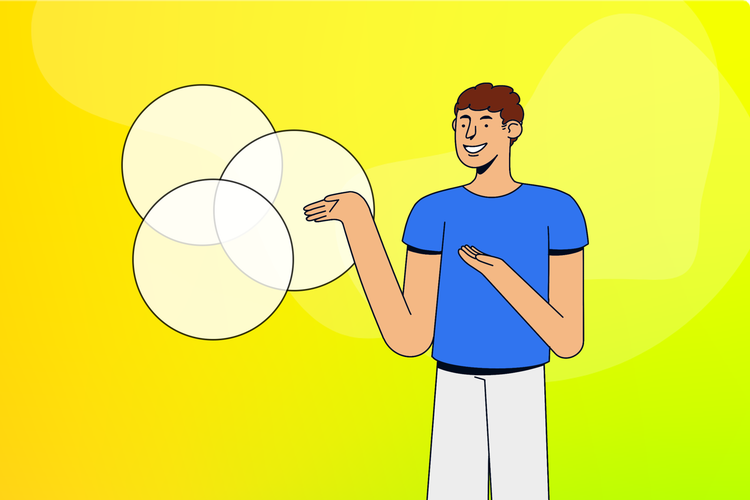
Key takeaways
- Venn diagrams help students compare, contrast, and organize ideas visually, making complex concepts easier to understand.
- They support stronger decision-making, critical thinking, and pattern recognition—skills students can use across subjects and grade levels.
- Great for any classroom, Venn diagrams work in math, science, humanities, and more—whether you're exploring equations or analyzing literature.
- Visual tools like Venn diagrams boost engagement and memory, helping students stay focused and retain what they learn.
- Adobe Express makes it easy to create ready-to-use Venn diagrams with free templates, fun design assets, and simple tools for both teachers and students.
Overview
What is a Venn diagram?
Though we have probably all used Venn diagrams for visualizing comparisons in a variety of settings — at school, work, or home — you may be wondering: just what is a Venn diagram?
Invented by the mathematician John Venn in the 1880s, this common graphic organizer is useful as a compare-and-contrast diagram that helps people visualize information and concepts in a clear and concise manner.
This type of diagram is easy for users to understand, while also being easy to create.
- Invented by mathematician John Venn in the 1880s
- Common graphic organizer used for comparing and contrasting
- Helps visualize information and concepts clearly and concisely
- Easy to understand and create
- Commonly referred to as an overlapping circles chart
Why is learning about Venn diagrams important?
There are many benefits to using Venn diagrams in your classroom. For teachers, Venn diagrams can help you quickly and effectively communicate differences and similarities, provide a simple visual aid for a lesson, or distinguish between multiple concepts or ideas.
When students create Venn diagrams, they are better able to make decisions, reason through logic, and detect patterns in data when they use tools like Venn diagrams to support their thinking. On a broader level, Venn diagrams can be an effective tool to aid students in visually organizing information, process the relationships and commonalities between items or groups, and develop a plan for a project.
For teachers:
- Quickly and effectively communicate differences and similarities
- Provide a simple visual aid for lessons
- Distinguish between multiple concepts or ideas
For students:
- Improve decision-making and logical reasoning
- Detect patterns in data
- Organize information visually
- Understand relationships and overlaps between items or groups
- Develop plans for projects
Benefits of data visualization
Data visualization enhances comprehension by making complex concepts easier to understand through clear and engaging visual representations. It promotes student engagement by capturing their attention and encouraging active participation. Additionally, Venn diagram components provide students with visual aids to improve memory retention, helping them recall information more effectively.
Data visualization improves the learning process by:
Enhancing comprehension:
- Visual aids help students grasp complex concepts more easily
- Makes abstract ideas more concrete
Promoting engagement:
- Interactive and visually appealing materials capture students' interest
- Encourages active participation in the learning process
Supporting retention:
- Visual representations aid in memory retention
- Helps students recall information more effectively
Venn diagram teaching strategies
If you’re wondering what Venn diagrams are used for, and what the benefits are of using a Venn diagram in your classroom, think about how frequently students practice comparing and contrasting items, concepts, or events. By overlapping circles, such as with three or four-way Venn diagrams, students can understand the commonalities between differing pieces of information.
Venn diagrams support many different teaching styles as well as a variety of academic subjects. Here are a few examples:
Math:
- Differentiate geometry concepts
- Show relationships between sets of equations
Social Sciences:
- Compare and contrast political ideologies, national identities, or historical periods
Humanities:
- Diagram characters from literature
- Compare works of different authors
Sciences:
- Compare biological, chemical, and physical processes
- Differentiate types of samples in a test or experiment
Other visualization tools
In addition to Venn diagrams, teachers can use a variety of other visualization tools to enhance learning and comprehension.
Slideshows and presentations:
- Provide a dynamic way to present information
- Engage students visually and keep their attention
- Allow for the inclusion of multimedia elements
- Enable students to collect and showcase their work
- Encourage reflection on learning progress and achievements
- Facilitate assessment of student growth over time
Concept maps and mind maps:
- Help students organize and structure their thoughts
- Show relationships between different concepts
- Aid in brainstorming and problem-solving activities
Make it personal
One of the major difficulties teachers face in preparing for class is creating materials — even simple ones like Venn diagrams. Luckily, Adobe Express has lots of templates to help you create beautiful classroom materials, handouts, visual aids, and assignments.
Adobe Express templates are great for Venn diagrams — even better than common online Venn diagram generators — because it takes all the hard or tedious parts of material creation out of the equation, and offers a variety of exciting tools for making your Venn diagram visually appealing. For teachers, this enables you to focus on preparing for class, while students love how easy it is to get started creating right away.
The free Venn diagram templates from Adobe Express are designed to be ready to use as soon as you login, with quick actions, a huge library of EDU-specific design assets like fonts and icons, cool image-editing tools, and more. No matter what you’re trying to accomplish, it’s easy to create a beautiful Venn diagram using Adobe Express.
Adobe Express benefits:
- Variety of templates for classroom materials, handouts, visual aids, and assignments
- Simplifies the creation of Venn diagrams
- Offers exciting tools for beautiful designs
- Easy to manipulate the parts of a Venn diagram
- Includes quick actions, a library of design assets, fonts, icons, and image-editing tools
- Easy for teachers to prepare materials and for students to get started creating right away
Customize your Venn diagram template today!
If you’re wondering how to make a Venn diagram, check out this template:
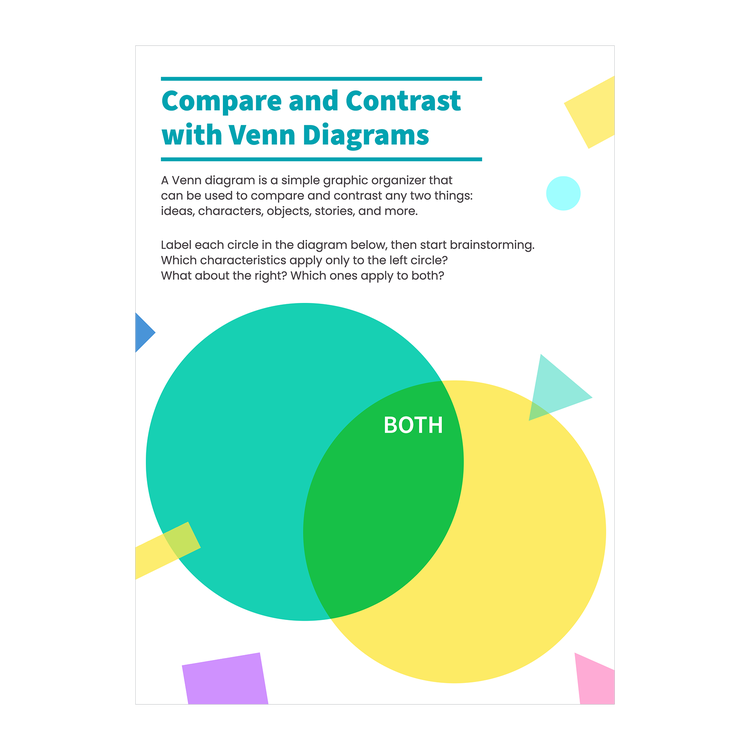
Browse through this collection of Venn diagram examples with plenty of colorful and educational options you can make your own.
Want to keep learning? Check out my self-paced Lightning Learning course on the Adobe Education Exchange to learn more about how to use graphic organizers in your classroom!
This post was updated on August 9, 2024.
Explore these Venn diagram examples.
Get started with professional-quality templates and design assets you can customize in minutes.
- Max Suechting
Doctoral candidate at Stanford University and the K-12 Content Lead for the Adobe Education Exchange. See his helpful Adobe for Education videos.
